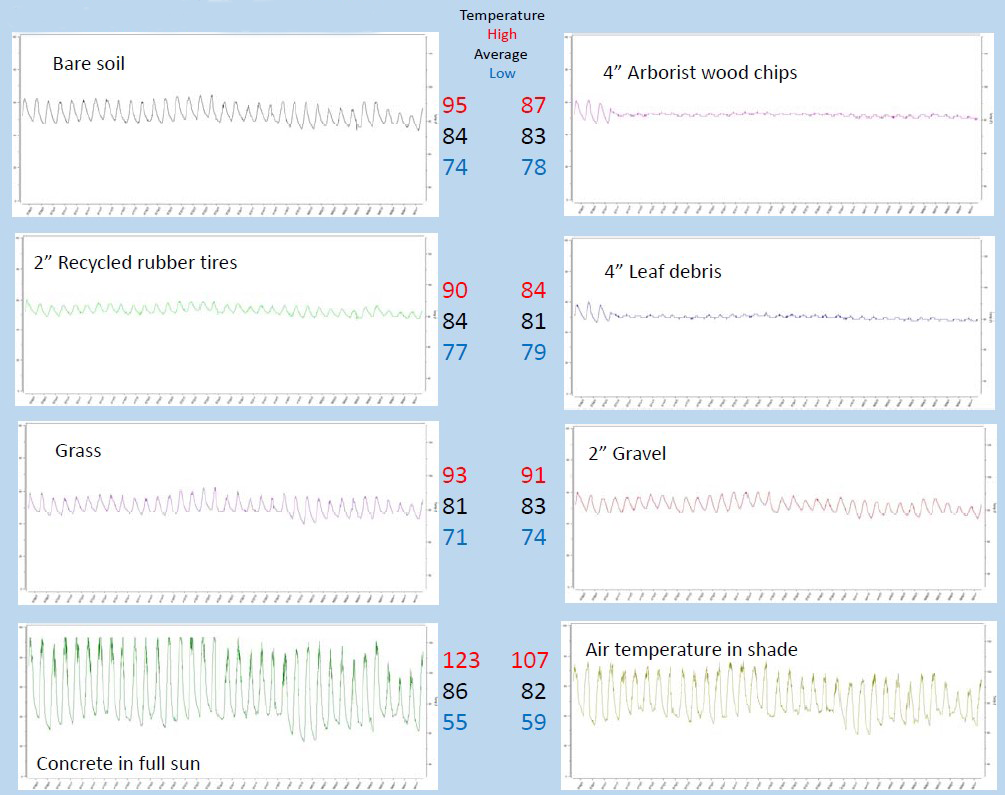
Benefits of Mulch in Regulating Soil Temperature

Contributor
- Topics: Drought and Fire Resilience
Fall 2022
One of the best things a gardener can do to help the trees in their care is to add an appropriate mulch ring around the base, ideally 2 to 4 inches deep, as wide as the drip line of the tree, while avoiding “mulch volcanoes”, a situation where mulch is piled up against the trunk. Not only does a properly mulched bed reduce the number of weeds, but it also lessens plant stress by eliminating competition from turf grass while simultaneously mimicking a natural forest environment. Appropriately applied mulch reduces soil erosion and moisture evaporation, as well as helping to regulate soil temperatures and adding organic material back into the soil when the mulch decomposes. All these factors together help maintain a healthy, stable soil biome.
At the Bartlett Tree Research Laboratory in Charlotte, North Carolina we decided to test some popular mulch types to see how they affected soil temperature. The mulch types trialed were wood chips, white river gravel, recycled shredded tire chunks dyed brown, and leaf debris gathered from the forest. In addition, we also put sensors in plots of bare soil and mowed turf grass as well as reading air temperature in the shade and a sensor mounted to a concrete block to simulate urban pavement. After laying out a grid, we buried temperature sensors 3 inches below the soil grade then applied mulch over top according to manufacturers specifications or industry standards. These plots were replicated at other sites around the country with readings recorded every 15 minutes from April to October.
We focused on the temperature swings (minimum to maximum) as well as average soil temperatures during a given period in the heat of the summer when tree stress is at its greatest. The results for a 30-day window in mid-summer showed that forest leaf debris worked the best for keeping the average soil temperature cool and keeping the min-max fluctuations to within 5 degrees, with wood chip mulch being a close second at a 9-degree fluctuation. The temperature fluctuations for turf grass and bare soil were over 21 degrees during the day/night cycle and the concrete in full sun rose and fell by over 68 degrees! Below is an example of a typical daily temperature fluctuation from the plot in July.
For More Information on Mulch Application Guidelines
RESEARCH LABORATORY TECHNICAL REPORT: Mulch Application Guidelines
by Drew C. Zwart, PhD, Plant Physiology
Soil Temperature Under Mulch Research
Tom Smiley, Ph.D. and Sean Henry
Bartlett Tree Research Laboratories
Purpose
To compare soil temperatures under different types of mulch. We believe that cooler more consistent summer temperatures, and warmer winter temperatures are beneficial for tree growth. We would like to know which mulches provide these conditions.

Materials and Methods
Soil temperature sensors are buried 3” below the soil surface. Mulch thickness are those recommended in industry BMPs or by product manufacturers:
Arborist wood chips 4”
Leaf Debris 4”
Gravel 2”
Recycled rubber tires 2”
Grass maintained at +5”
Installed July 10, 2017.
Replicated in CA, AZ, TX, and NJ
Results
The arborist wood chips and forest‐like leaf debris both greatly reduced temperature fluctuations in the soil. Lowest mean temperatures were found under the leaf debris and grass. The peak high temperatures were lowest with leaf debris and wood chips.
Preliminary Conclusions
Leaf debris and wood chips have so far provided the most favorable conditions for root development, with less temperature fluctuation and moderate soil temperature means.
Resources:
Bartlett Tree Research Laboratories
Bartlett Tree Tips: Summer 2022 California Newsletter
Bartlett Tree Tips: Autumn 2022 Pacific Northwest Newsletter
Sign up to receive Bartlett Tree Tips Newsletter Here
Share:
Social Media
Garden Futurist Podcast
Most Popular
Videos
Topics
Related Posts

Design Futurist Award Announced: Committee Shares Vision
March 8, 2023 At Pacific Horticulture, we believe that beauty can be defined not only by gorgeous plants and design, but also by how gardens

Expand Your Palette: Waterwise Plants for your Landscape
There’s nothing more thrilling to plant lovers than discovering new plants to test in the garden. Here in the southernmost corner of California, we have

What Climate is This? Part Two – A Garden Futurist Special
Winter 2022 Listen to the Part 2 Podcast here. If you live in the Pacific region, you know that seasons in your garden look different

Portland Parks’ “Nature Patches”
Winter 2022 Nature is so beautiful when left to its own devices, yet crisply manicured lawns remain a status symbol. This is true in Portland,















Responses